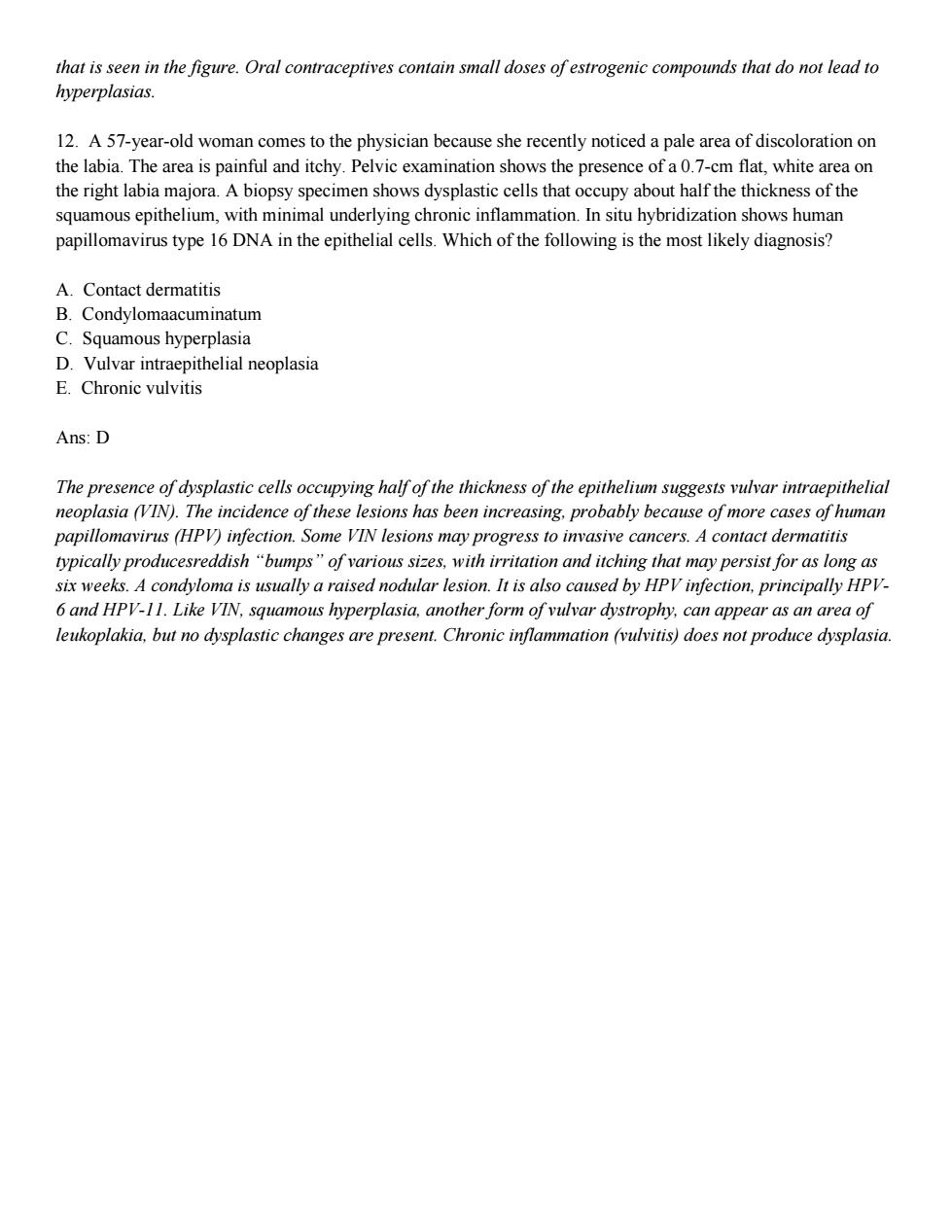正在加载图片...

that is seen in the figure.Oral contraceptives contain small doses ofestrogenic compounds that do not lead to hyperplasias. 12.A 57-year-old woman comes to the physician because she recently noticed a pale area of discoloration on the labia.The area is painful and itchy.Pelvic examination shows the presence of a 0.7-cm flat,white area on the right labia majora.A biopsy specimen shows dysplastic cells that occupy about half the thickness of the squamous epithelium,with minimal underlying chronic inflammation.In situ hybridization shows human papillomavirus type 16 DNA in the epithelial cells.Which of the following is the most likely diagnosis? A.Contact dermatitis B.Condylomaacuminatum C.Squamous hyperplasia D.Vulvar intraepithelial neoplasia E.Chronic yulvitis Ans:D The presence of dysplastic cells occupying half of the thickness of the epithelium suggests vulvar intraepithelial neoplasia (VIN).The incidence of these lesions has been increasing.probably because of more cases of human papillomavirus (HPV)infection.Some VIN lesions may progress to invasive cancers.A contact dermatitis typically producesreddish "bumps"of various sizes,with irritation and itching that may persist for as long as six weeks.A condyloma is usually a raised nodular lesion.It is also caused by HPV infection,principally HPV- 6 and HPV-11.Like VIN.squamous hyperplasia,another form of vular dystrophy. can appear as an area of leukoplakia,but no dysplastic changes are present.Chronic inflammation (vulvitis)does not produce dysplasia.that is seen in the figure. Oral contraceptives contain small doses of estrogenic compounds that do not lead to hyperplasias. 12. A 57-year-old woman comes to the physician because she recently noticed a pale area of discoloration on the labia. The area is painful and itchy. Pelvic examination shows the presence of a 0.7-cm flat, white area on the right labia majora. A biopsy specimen shows dysplastic cells that occupy about half the thickness of the squamous epithelium, with minimal underlying chronic inflammation. In situ hybridization shows human papillomavirus type 16 DNA in the epithelial cells. Which of the following is the most likely diagnosis? A. Contact dermatitis B. Condylomaacuminatum C. Squamous hyperplasia D. Vulvar intraepithelial neoplasia E. Chronic vulvitis Ans: D The presence of dysplastic cells occupying half of the thickness of the epithelium suggests vulvar intraepithelial neoplasia (VIN). The incidence of these lesions has been increasing, probably because of more cases of human papillomavirus (HPV) infection. Some VIN lesions may progress to invasive cancers. A contact dermatitis typically producesreddish “bumps” of various sizes, with irritation and itching that may persist for as long as six weeks. A condyloma is usually a raised nodular lesion. It is also caused by HPV infection, principally HPV- 6 and HPV-11. Like VIN, squamous hyperplasia, another form of vulvar dystrophy, can appear as an area of leukoplakia, but no dysplastic changes are present. Chronic inflammation (vulvitis) does not produce dysplasia